Govan Old Parish Church
Govan Old Parish Church is the name of the original parish church serving Govan in Glasgow from the 6th century until 2007. In that year, the Church of Scotland united the two Govan congregations with Linthouse and established the parish church at Govan Cross, making Govan Old redundant. Govan Old Church is no longer used for regular Sunday services, but the building remains a place of worship with a daily morning service and is open to visitors in the afternoons. The church dedicated to Saint Constantine of Strathclyde occupies a Scottish Gothic Revival building of national significance (A-Listed by Historic Environment Scotland) within a churchyard designated a Scheduled Ancient Monument (Historic Environment Scotland). The church houses an internationally significant collection of early medieval sculpture known as Govan Stones. All the carved stones come from the churchyard and including interlace-decorated crosses, hogbacks, and burial monuments dating to the 9th - 11th centuries AD. Govan Old and the Govan Stones are open daily between April 1 and October 31 from 1pm-4pm. Admission to the museum is by donation.
| Govan Old Parish Church | |
|---|---|
 | |

| |
| 55°51′53″N 4°18′46″W | |
| Location | Glasgow |
| Country | Scotland |
| Denomination | Church of Scotland |
| Website | Church website |
| History | |
| Status | Active |
| Founded | c. 6th Century |
| Dedication | Constantine of Strathclyde |
| Dedicated | 1908 |
| Architecture | |
| Functional status | Church & Museum |
| Architect(s) | Robert Rowand Anderson |
| Years built | 1883-1888 |
| Administration | |
| Presbytery | Presbytery of Glasgow |
Listed Building – Category A | |
| Designated | 6 July 1966 |
| Reference no. | LB33353 |
Creation of the site
It is believed that the site's earliest Christian activity began sometime in the 6th century AD. Archaeological excavations in the 1990s uncovered two early Christian burials beneath the foundations of a later church; these burials were radiocarbon-dated between the 5th and 6th centuries AD (AD 435-601 and AD 474 -601).[1] Despite this early activity, it wasn't until the 9th and 10th centuries that Govan Old rose to prominence. There are few historical references to Govan in the interim, though there appears to be one reference included in Simeon of Durham's ‘Historia Regum Anglorum’, compiled sometime in the 12th century AD. In it, Simeon records the return of the Northumbrian army from Ovania after attacking Dumbarton in 756 AD.[2][3]
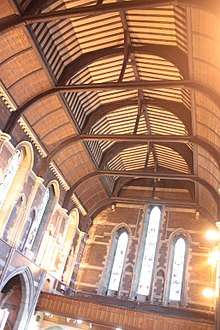
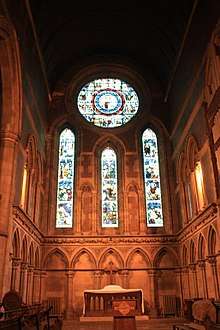
Originally, the Annals of Ulster recorded Dumbarton Rock as the centre of the British Kingdom of Al Clud (usually pre-emptively referred to as the Kingdom of Strathclyde, but which is more accurately described as ‘the kingdom on the Clyde’) from the 6th century AD until the later 9th century AD. In the year 870 AD, the annals record a Viking raid on Dumbarton Rock; after this point, the kings of Clyde Rock are no longer discussed.[4][5] In 872 AD, the Annals of Ulster instead refer to the kingdom of Ystrad Clud, better known as the kingdom of Strathclyde,[6] which appears to mark the shift of political power from Dumbarton Rock further upstream to Govan. It is possible that a predecessor of the 12th century royal estate at Partick[7][8] and the now-destroyed Doomster Hill (which is thought to have functioned as a moot hill or meeting place[9][10][11]) played a part in this power shift. The size of the graveyard and the sheer amount of early medieval sculpture suggest that the church was supported by royal patronage. Because the site has been in continual use since it was first established, it is impossible to tell what the original church looked like, but it is clear that it always had Christian associations.
Building
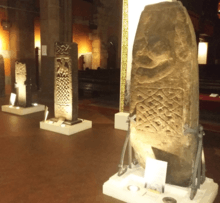
Govan Old Parish Church is an ornate, Category A listed building[12] of significant architectural merit, designed by Robert Rowand Anderson[13] and influenced by features at Pluscarden Abbey near Elgin. Govan has, however, known considerable socio-economic problems and has been severely affected by the decline in the shipbuilding industry.
The current church building was constructed in 1888, although the site is one of the oldest places of Christian worship in Scotland. Unusually, the axis of the church was turned to orientate north-south rather than the traditional east-west orientation, but this allowed the main door to face south to the main street.
Upon construction, the congregation was closely associated with the Scoto-Catholic High Church movement within the Church of Scotland—several former ministers have been actively involved with the Scottish Church Society. Notable former ministers include the Reverend George MacLeod, later the Lord MacLeod of Fuinary, and Norman Shanks, Leader of the Iona Community from 1995 to 2002.[14]
Govan Old also has noteworthy stained glass windows. Two of the church's windows were given by Robert Malcolm Kerr; the Emmaus window in 1891, and Christ blessing the children in 1902. Both were made by Heaton, Butler and Bayne.[15][16]
The church's collection of early Christian carved stones is of international significance. This was first properly recognised in December 1855 when the digging of a grave led to the rediscovery of the sarcophagus.[17] The exciting discovery prompted scholars to illustrate and record the sarcophagus and other early medieval monuments in the churchyard. A photographic record of forty-six carved stones was commissioned and published by John Stirling Maxwell.[18] For this publication, Robert Foster of Stirling made plaster casts of each of the stones;[19] these casts were then taken to the studio of renowned photographers T & R Annan & Son and photographed in ideal lighting conditions to emphasise the carving.[20][21] These photographs were used in the J. Romilly Allen and Joseph Anderson's Early Christian Monuments of Scotland, though only thirty-nine were included in their volume;[22] however, of these thirty-nine, one stone was not recorded by Stirling Maxwell, which puts the number of probable early medieval stones from Govan at forty-seven. Jumping forward to the 1960s, Ralegh Radford saw the stones as a means to understand Govan's early significance and made close comparisons between the carved stones from Govan and those found at Inchinnan,[23] which, along with other monuments in the region, are described as belonging to a ‘Govan School’ of carving.[24][25]
Today, thirty monuments are currently on display inside the church, and a single recumbent monument of medieval date remains in the graveyard. Sixteen of the stones that were not brought into the church were thought to have been buried or removed after the demolition of the Harland & Wolff factory building in 1973,[26] but a recent community archaeology dig identified the location of at least three of the lost stones.[27] Work in the near future will assess how many of the ‘lost’ stones survive. Of the thirty-one monuments on display at Govan Old, there is one sarcophagus, two cross-shafts, two upright cross-slabs, five hogbacks, and twenty-one recumbent cross-slabs.[28]
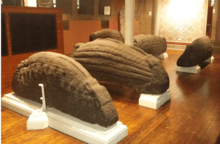
Govan sarcophagus
The Govan sarcophagus is a stone coffin with a carved exterior; it was rediscovered when the sexton was digging a grave in the south-east corner of the churchyard in December 1855,[29] surrounded by roots from two elm trees. No human remains were found with the sarcophagus, so it is thought that it was buried at an earlier date to protect the monument, perhaps during the Scottish Reformation when iconoclasm was common practice. Today, the sarcophagus is on display in the modern Govan Old Parish Church Museum.
The sarcophagus is supposed to have been dedicated to the patron saint of the church, St Constantine. There is much debate over which Constantine is the patron, and whether it is Constantine of Strathclyde, but most scholars agree that the coffin most likely would have been dedicated to Constantine f. Kenneth (AD 862-878)[30] or Donald f. Constantine (AD 889-900).Because of its highly decorated exterior, it is assumed that the coffin was meant to display the remains of the saint as a focal piece in the church.
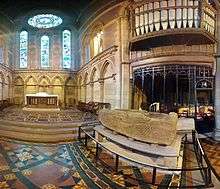
The coffin itself depicts Insular iconography, taking inspiration from different styles that were then popular in the Irish sea region. One face of the sarcophagus shows a hunting scene of a horseman chasing a stag, perhaps accompanied by a dog, a motif frequently used in Pictish art that is thought to convey an association with royalty and power. The sarcophagus also shows an animal trampling another; the angular decoration of the triumphant animal has led many scholars to suggest that this is a ‘Lamb of God’ motif.[31] Two panels depicting beasts in various configurations are found on the other long face of the sarcophagus: in one, four ‘beasts’ are pseudo-mirrored across the vertical and horizontal axes of the panel, though there are differences in each beast's design. In the second panel, two long-necked animals cross necks and interlace their tongue/ears with the other beast's tail; similar motifs, where beasts cross legs, necks, or other body parts, can also be found in Pictish sculpture. The rest of the space on the sarcophagus is filled with panels of median-incised interlace, some of which represent snakes, which a relatively common motif in Insular sculpture, thought to be a symbol of death and resurrection.[32]
Crosses and Upright Cross-slabs
Two cross-shafts and two upright cross-slabs are on display in the Govan Old museum. The two cross-shafts include the iconic Jordanhill cross and the ‘Inverted (or Upside Down) Cross’. These would have been decorated on all four faces and, when whole, would have been part of a free-standing cross, probably in a form similar to the more intact Barochan Cross, now housed at Paisley Museum.
The Jordanhill cross is so named because it was gifted to the residents of Jordanhill House at some point when one of the churches was being replaced, though there are conflicting accounts as to when this took place.[33][34] It was brought back to Govan Old in 1928. The cross is decorated with different variants of median-incised interlace, though its most notable feature is an eroded man on horseback that has lost much of its detail apart from the eyes of both horse and man.
The ‘Inverted’ or ‘Upside Down’ cross is so named because it is currently displayed upside down. Though most of the details on the broad faces of the cross have been damaged or eroded, the two smaller faces are comparatively well-preserved. These are mostly decorated with median-incised interlace, though this also retains the only figural sculpture that can be interpreted as a biblical scene – possibly David being anointed by Samuel.[35]
The two upright cross-slabs include the ‘Sun Stone’ and the ‘Cuddy Stane’. The ‘Sun Stone’ is heavily eroded, but it is decorated with a large boss from which emerge four snakes, arranged in such a way that it appears ‘sun-like’, above an angular interlace panel. On the other broad face it is decorated with a cross, median-incised interlace, and a rider on one face. Though there is a tenon on top of the stone slab, scholars have argued this would not have supported a cross -head and could indicate that the Sun Stone played an architectural function.[36][37]
The ‘Cuddy Stane’ has gotten its name from its rider's steed, which appears more like a donkey than a horse. The stone has been damaged since it was illustrated in 1856,[38] which records the rider's upper half and the shape of the cross-head. While the stone appears plain today, this is likely because it has been severely eroded; hints of a panel of interlace are preserved under the horseman.
Hogbacks
Hogbacks are recumbent stone monuments found across Scotland and Northern England that date to the 10th – 11th centuries AD; the term ‘hogback’ was established prior to 1885 to describe the characteristic curved ridge of the monument.[39] Hogbacks are often decorated with rows of tegulation on the broad faces and each end often sports stylised or naturalistic beasts, though there is substantial variation on these traits from monument to monument. The tegulation has led many to argue that hogbacks are meant to emulate a house-shape, specifically Scandinavian long houses.[40]
Five hogbacks are housed at Govan Old, the largest collection of hogbacks in Scotland; four of these are the largest known hogbacks in all of Great Britain. The smallest of the hogbacks (SM 2, ECMS 2, Lang 1) is the best preserved and exhibits the most decoration; it has been suggested that this style has similarities to sculpture in Cumbria . Two of the hogbacks have each been recut to resemble a single beast, though it is unclear when this took place.[41] Three of the hogbacks have concave tegulation, while the other two exhibit straight-sided ‘shingles’.
Recumbent cross-slabs
The recumbent cross-slabs take up the largest proportion of the collection at Govan Old; twenty-one of the originally recorded thirty-seven are on display. Unfortunately these monuments have received the least amount of attention because they have been differentially worn and liberally reused since at least the 17th century. While the cross-slabs vary in size, in shape and in the decorative motifs used, there are some features they share. They each exhibit a cross with an incised border, which consistently divides the stone into at least two panels. For each stone there is a plain border that defines the edge of the monument. Finally, of the twenty-one recumbent cross-slabs on display, at least five show evidence for a regionally significant feature known as ‘angle-knobs ’.[42]
These tombstones are of particular importance to any future tourism development and hold great potential.[43]
Amalgamation
Following arbitration, the Church of Scotland's Presbytery of Glasgow decided upon a union of the three local Church of Scotland congregations in the Govan area. Govan Old (along with the charges of Linthouse St. Kenneth and New Govan) was terminated on 28 October 2007, becoming part of Govan and Linthouse parish and congregation. The future of the Govan Old Parish Church building remains uncertain as the united congregation continues to use all three original buildings, albeit with the former New Govan building being the main centre of worship.
After 2007, the future of the Govan Old Parish Church was uncertain. In 2008, an Options Appraisal study was undertaken by Govan Workspace Ltd, who then took the lead in applying for funding to redisplay the sculpture.[44] The funding was secured in 2011, allowing the redisplay to be completed by Northlight Heritage/York Archaeological Trust in 2013.[45] Govan Old's future was secured when the Govan Heritage Trust obtained a grant from the Scottish Government in 2016.[46] The Trust aims to develop the church into a self-sustaining community-run cultural, museum and business complex but requires further financial support from the community to bring to fruition.[47]
The former minister of the Govan and Linthouse Parish Church was Rev Dr Moyna McGlynn, who passed away in August 2016. The current interim minister of the Govan and Linthouse Parish Church is the Reverend Eleanor McMahon.
The church is located near Govan Station on the Glasgow Subway.
Notable ministers
- Andrew Melville 1577-1580
- Thomas Smeaton 1580-1584
- Patrick Sharp (theologian) 1585-1614
- Robert Boyd (university principal) 1615-1621
- Hugh Binning 1650-1653
- Very Rev Matthew Leishman DD 1794-1874), father of Thomas Leishman, Matthew was Moderator of the General Assembly of the Church of Scotland in 1858, was minister of the parish 1821 to 1874, a remarkable 53 years.[48]
- George MacLeod 1930-1938 when he left Govan in 1938 he founded the Iona Community
- David Orr (1960–80), whose efforts led to the establishment of the Govan Housing Association.[49]
- Tom Davidson Kelly (1989-2002) established the Friends of Govan Old and brought attention to the early medieval sculpture at Govan by persuading scholars to consider the collection at a conference in 1992.[50]
- Moyna McGlynn (2008-2016) maintained the building after its closure and supported the old congregation, allowing time for a community-based trust to assume responsibility for the site.
See also
References
- Driscoll, Stephen (2004). Govan from Cradle to Grave (PDF). Glasgow: Friends of Govan Old. p. 8. ISBN 0954532120.
- Breeze, Andrew (1999). "Simeon of Durham's annal for 756 and Govan, Scotland". Nomina. 22: 133–137.
- Forsyth, Katherine (2000). "Evidence of a lost Pictish source in the Historia Regum Anglorum of Symeon of Durham". In Taylor, Simon (ed.). Kings, Clerics and Chronicles in Scotland, 500-1297. Four Courts Press. pp. 19–34. ISBN 9781851825165.
- Alcock, L; Alcock, E.A. (1990). "Reconnaissance excavations on Early Historic fortifications and other royal sites in Scotland, 1974-84: 4, Excavations at Alt Clut, Clyde Rock, Strathclyde, 1974-75" (PDF). Proceedings of the Society of Antiquaries of Scotland. 120: 95–149.
- Clancy, Thomas (2006). "Constantine, St. (of Govan)". In Koch, John (ed.). Celtic Culture: A Historical Encyclopedia. ABC-Clio. p. 1818.
- Clancy, Thomas (2006). "Constantine, St. (of Govan)". In Koch, John (ed.). Celtic Culture: A Historical Encyclopedia. ABC-Clio. p. 1819.
- Macquarrie, Alan (1994). "The historical context of the Govan stones". In Ritchie, Anna (ed.). Govan and its early medieval sculpture. Alan Sutton publishing limited. p. 29. ISBN 9780750907170.
- Driscoll, Stephen (2004). Govan from Cradle to Grave (PDF). Glasgow: Friends of Govan Old. pp. 17–20. ISBN 0954532120.
- Crawford, Barbara (2005). The Govan Hogbacks and the Multi-Cultural Society of Tenth-Century Scotland. Glasgow: Friends of Govan Old. ISBN 0-9545321-3-9.
- Driscoll, Stephen (2004). Govan from Cradle to Grave (PDF). Glasgow: Friends of Govan Old. p. 20. ISBN 0954532120.
- Davidson Kelly, T.A. (1994). "The Govan collection in the context of local history". In Ritche, Anna (ed.). Govan and its early medieval sculpture. Alan Sutton Publishing Limited. pp. 1–3. ISBN 9780750907170.
- "Govan Old Parish Church". Historic Scotland. Retrieved 6 October 2014.
- McKinstry, Sam. "The Architecture of Govan Old Parish Church". The Architecture of Govan Old Parish Church.
- Ferguson, Ron (2004). George MacLeod: Founder of the Iona Community. Wild Goose Publications. ISBN 1901557537.
- Kerr on the Govan Old Church website Archived 7 March 2014 at the Wayback Machine
- Rush, Sally Joyce (1990). The stained glass windows of Govan Old Parish Church. Glasgow: Friends of Govan Old. ISBN 0951178245.
- Stuart, John (1856). The Sculptured Stones of Scotland. Aberdeen: Aberdeen Spalding Club. p. 43.
- Stirling Maxwell, John (1899). Sculptured Stones in the Kirkyard of Govan. Glasgow: For private circulation.
- Foster, Sally (March 2015). "Circulating Agency: The V&A, Scotland and the multiplication of plaster casts of 'Celtic Crosses'". Journal of the History of Collections. 27 (1): 74.
- Allen, J. Romilly (1897). "Report on the Photography of the Sculptured Stones earlier than A.D. 1100, in the District of Scotland south of the river Dee; obtained under the Jubilee Gift of His Excellency Dr. R. H. Gunning, LL.D., F.S.A. Scot" (PDF). Proceedings of the Society of Antiquaries of Scotland. 31: 148.
- Driscoll, Stephen (2016). "Reading Govan Old: interpretative challenges and aspirations" (PDF). In Hunter, Fraser; Sheridan, Alison (eds.). Ancient Lives: Object, People and Place in Early Scotland, Essays for David V Clarke on his 70th Birthday. Sidestone Press. p. 76.
- Allen, J. Romilly; Anderson, Joseph (1903). The Early Christian Monuments of Scotland. Balgavies, Angus: 1993 reprint: The Pinkfoot Press.
- Radford, C.A.R. (1967). "The Early Christian Monuments at Govan and Inchinnan". Transactions of the Glasgow Archaeological Society. 15 (4): 173–188.
- Driscoll, S T; O'Grady, O; Forsyth, K S (2005). "The Govan School revisited: searching for meaning in the early medieval sculpture of Strathclyde". In Foster, S; Cross, M (eds.). Able Minds and Practised Hands. Historic Scotland. pp. 135–158.
- Macquarrie, Alan (2006). Crosses and Upright Monuments in Strathclyde: Typology, Dating, and Purpose. Glasgow: Friends of Govan Old. ISBN 0-9545321-4-7.
- Davidson Kelly, T.A. (1994). "The Govan collection in the context of local history". In Ritchie, Anna (ed.). Govan and its early medieval sculpture. Alan Sutton Publishing Limited. p. 6. ISBN 9780750907170.
- The Govan Stones (25 March 2012). "Lost carvings of the ancient Kingdom of Strathclyde turn up in Govan Graveyard". The Govan Stones News.
- "Early Christian stones". Clyde Waterfront Heritage. Archived from the original on 9 April 2012. Retrieved 19 June 2011.
- Stuart, John (1856). The Sculptured Stones of Scotland. Aberdeen: Spalding Club. p. 43.
- Davies, John Reuben (2010). The Cult of Saint Constantine. Glasgow: Friends of Govan Old. ISBN 978-0-9545321-8-5.
- Spearman, R.M. (1994). "The Govan sarcophagus: an enigmatic monument". In Ritchie, Anna (ed.). Govan and its early medieval sculpture. Alan Sutton Publishing Limited. p. 43. ISBN 9780750907170.
- Mac Lean, Douglas (1993). "Snake-Bosses and Redemption at Iona and in Pictland". In Spearman, Michael; Higgitt, John (eds.). The Age of Migrating Ideas: Early Medieval Art in Northern Britain and Ireland. Alan Sutton Publishing Limited. p. 251.
- Stuart, John (1856). The Sculptured Stones of Scotland. Aberdeen: Spalding Club. p. 43.
- Macquarrie, Alan (2006). Crosses and Upright Monuments in Strathclyde: Typology, Dating, and Purpose. Glasgow: The Friends of Govan Old. p. 3.
- Fisher, Ian (1994). "The Govan cross-shafts and early cross-slabs". In Ritchie, Anna (ed.). Govan and its early medieval sculpture. Alan Sutton Publishing Limited. p. 49. ISBN 9780750907170.
- Fisher, Ian (1994). "The Govan cross-shafts and early cross-slabs". In Ritchie, Anna (ed.). Govan and its early medieval sculpture. Alan Sutton Publishing Limited. p. 51. ISBN 9780750907170.
- Macquarrie, Alan (2006). Crosses and Upright Monuments in Strathclyde: Typology, Dating, and Purpose. Glasgow: The Friends of Govan Old. p. 5.
- Stuart, John (1856). The Sculptured Stones of Scotland. Aberdeen: Spalding Club.
- Ritchie, Anna (2004). Hogback gravestones: at Govan and beyond. Glasgow: Friends of Govan Old. p. 6.
- Schmidt, H. (1973). "The Trelleborg house reconsidered". Medieval Archaeology. 17: 76.
- Lang, James (1994). "The Govan hogbacks: a reappraisal". In Ritchie, Anna (ed.). Govan and its early medieval sculpture. Alan Sutton Publishing Limited. pp. 125–129. ISBN 9780750907170.
- Cramp, Rosemary (1994). "The Govan recumbent cross-slabs". In Ritchie, Anna (ed.). Govan and its early medieval sculpture. Alan Sutton Publishing Limited. pp. 55–62. ISBN 9780750907170.
- Butler, Richard; Curran, Ross; O'Gorman, Kevin D. (1 September 2013). "Pro-Poor Tourism in a First World Urban Setting: Case Study of Glasgow Govan". International Journal of Tourism Research. 15 (5): 443–457. doi:10.1002/jtr.1888. ISSN 1522-1970.
- Driscoll, Stephen (2016). "Reading Govan Old: interpretative challenges and aspirations" (PDF). In Hunter, Fraser; Sheridan, Alison (eds.). Ancient Lives: Object, People and Place in Early Scotland, Essays for David V Clarke on his 70th Birthday. Sidestone Press. pp. 79–80.
- The Govan Stones (25 March 2012). "The Redisplay Project". The Govan Stones.
- Gardiner & Theobold (14 June 2018). "Govan Old's Future Secured". Govan Old's Future Secured.
- The Govan Stones. "The Govan Stones Appeal". The Govan Stones Appeal.
- "Moderators of the General Assembly of the Church of Scotland genealogy project".
- Driscoll, Stephen (2016). "Reading Govan Old: interpretative challenges and aspirations" (PDF). In Hunter, Fraser; Sheridan, Alison (eds.). Ancient Lives: Object, People and Place in Early Scotland, Essays for David V Clarke on his 70th Birthday. Sidestone Press. p. 85.
- Driscoll, Stephen (2016). "Reading Govan Old: interpretative challenges and aspirations" (PDF). In Hunter, Fraser; Sheridan, Alison (eds.). Ancient Lives: Object, People and Place in Early Scotland, Essays for David V Clarke on his 70th Birthday. Sidestone Press. p. 79.
External links
- Website of the former Govan Old Parish Church
- The 'Celtic Interlace' stones at Govan.
- The 'Viking Hogback' stones and the 'Govan Sarcophagus'- video, narration and annotation.
- News report in the Glasgow Evening Times
- Govan and Linthouse Parish Church
- Govan Old Parish Church history - Clyde Waterfront Heritage
- Govan Old Parish Church - CANMORE Record, Historic Environment Scotland